Full Text View
Volume 29 Issue 10 (October 2019)
GSA Today
Article, pp. 4-10 | Abstract | PDF (1.5MB)
The Role of Introductory Geoscience Courses in Preparing Teachers—And All Students—For the Future: Are We Making the Grade?
Cover Image
Table of Contents
Search Google Scholar for
Search GSA Today
Abstract
Introductory geoscience courses enroll hundreds of thousands of students a year, most of whom do not major in the geosciences. For many, including future K–12 teachers, an introductory course is the only place they will encounter Earth science at the college level. New standards for K–12 science education have profound implications for teacher preparation, particularly in Earth science. The new standards call for taking a systems approach, highlighting how humans interact with Earth, making use of science and engineering practices, and engaging students in discourse. Analysis of responses to the National Geoscience Faculty Survey (n = 813 in 2004; n = 994 in 2009; n = 972 in 2012; and n = 1074 in 2016) and data from 152 syllabi suggest that a systems approach is not widespread and human interactions with Earth are not emphasized, and that most instructors engage students in mostly low cognitive-level practices. While the use of discourse practices has increased over time, these and other active learning components are not yet widely included in students’ grades. These results suggest that courses are not currently well-aligned with teacher needs. However, instructors have access to many research-based instructional resources to support them in making changes that will help all students—including future teachers.
Manuscript received 25 Oct. 2018. Revised manuscript received 3 Apr. 2019. Manuscript accepted 12 Apr. 2019. Posted 10 May 2019.
© The Geological Society of America, 2019. CC-BY-NC.
Introduction
Several hundred thousand students enroll annually in introductory geoscience courses at institutes of higher education (Martinez and Baker, 2006). Fewer than 4000 students a year graduate with undergraduate degrees in geoscience (Wilson, 2016), however, which means that these courses serve a very large population of students that major in anything other than the geosciences. Few science majors require their students to take a geoscience course—it is not common for biology (Cheesman et al., 2007), nor recommended as a cognate for chemistry (ACS-CPT, 2015). In most cases, therefore, students enroll in geoscience courses to fulfill a general education requirement (Gilbert et al., 2012). Within this audience is a group of students that will become K–12 teachers, as most traditional teacher preparation programs do not include specific science content courses as part of their curricula (NRC, 2010). In the current teaching workforce, 64% of middle school teachers and 42% of high school teachers assigned to teach Earth science took no geoscience courses beyond introductory (Banilower et al., 2013). One critical purpose that introductory geoscience courses serve, therefore, is providing future teachers with their primary college- level Earth-science experience.
While it is easy to lament the numbers, teacher preparation is part of a complex system influenced by state certification, district needs and requirements, university degree requirements, and many other components (NRC, 2010). Within this complex system, disciplinary departments at institutes of higher education often play the role of content providers. Given this role, how well do introductory courses in the geosciences serve the population of future teachers?
Background
Starting in 2007, communities of scientists developed consensus documents that define what every citizen should know about climate science (Climate Literacy Network, 2009), atmospheric science (UCAR, 2007), the oceans (Ocean Literacy Network, 2013), and Earth science (ESLI, 2010). A few years later, work began at the national level to develop a new set of science standards for grades K–12. An early step in that process was the publication of the Framework for K–12 Science Education (NRC, 2012b), which articulates three interconnected dimensions: science and engineering practices, cross-cutting concepts, and disciplinary core ideas. The disciplinary core ideas in the Earth and space sciences (Earth’s place in the universe, Earth’s systems, and Earth and human activity) emerged from the literacy documents, and thus represent a broad consensus of the scientific community (Wysession, 2012). The Framework provided guidance for the development of the Next Generation Science Standards (NGSS), which consist of a limited number of rigorous learning goals expressed as performance expectations (PEs) that integrate the three dimensions (see Table S1 in the GSA Data Repository1) (NGSS Lead States, 2013).
-------
1GSA Data Repository item 2019217, which includes methods, additional survey results, and selected components of the Next Generation Science Standards,
is online at www.geosociety.org/datarepository/2019.
The vision for K–12 science education in the Framework and NGSS represents a significant shift conceptually and pedagogically, especially in Earth science. Conceptually, the NGSS take a systems approach, emphasizing the dynamic interactions between the atmosphere, ocean, land, and life—an approach that has been advocated for more than 20 years (e.g., Ireton et al., 1996) but has been slow to be adopted. The system includes humans, too: no longer, for example, will it be sufficient for students to describe the global distribution of resources. In the new standards, the PEs ask students to tie that distribution to human activity and assess the impacts of resource extraction on the environment (Table S1 [see footnote 1]).
Pedagogically, integrating the three dimensions requires that “students actively engage in scientific and engineering practices in order to deepen their understanding of cross-cutting concepts and disciplinary core ideas” (NRC, 2012b, p. 217). The structure of this sentence is purposeful: active engagement in the practices comes first and leads to deeper understanding. The practices describe the use of data as the foundation for developing explanations that are modified and refined through active discourse (Table S2 [see footnote 1]). In Earth science, the PEs shift the focus from identification and description of Earth materials and landforms to analyzing geoscience data to construct explanations, make decisions, and evaluate solutions (Table S1 [see footnote 1]). Together, these changes led Wysession (2014) to assert that “the NGSS provide America’s best opportunity yet in its almost 240-year history to educate its citizens about the complex and critical issues of Earth science.”
This is an exciting development for the Earth-science community but one that will not be fully realized without deliberate effort from all components of the educational system. Because a powerful way that teachers learn to teach is by observation, mimicking the teaching strategies they have experienced as learners (Windschitl and Stroupe, 2017), one key leverage point for effecting change is the science courses that future teachers take. In the geosciences, we have two rich data sets that can be explored to assess the extent to which introductory geoscience courses align with the vision of the Framework. The National Geoscience Faculty Survey (NAGT, 2018) was administered in 2004, 2009, 2012, and 2016. The original survey was developed before the Framework, but is based on the same foundational documents. Over the four administrations, 3853 responses address introductory courses. A second data set comes from participants in professional development opportunities (PD) led by On the Cutting Edge (Manduca et al., 2010), who uploaded syllabi to a digital repository, where they are publicly available (SERC, 2002). The methods of analysis of these two data sets are described in the GSA Data Repository (see footnote 1).
Results
Demographics
The number of respondents who completed the survey describing an introductory course they teach has been ~1000 for the past three administrations (Table S3 [see footnote 1]); responses come from all institution types, as do the 152 syllabi uploaded between 2002 and 2016 (Table S4 [see footnote 1). Although the distribution across institution types differs somewhat, both fall within range of an earlier report on introductory courses (Martinez and Baker, 2006). Both data sets include courses that span the disciplines in the geosciences, with the largest combined numbers in Earth science, geology, and oceans (Table 1), which are among the courses current teachers most commonly report having taken as undergraduates (Banilower et al., 2013).
The total number of students enrolled in the introductory courses represented in the survey responses ranges from a low of 66,725 in 2004 to a high of 81,636 in 2009, followed by 68,170 in 2012 and 70,198 in 2016. This represents about a third of students counted through departmental responses to a survey describing 2004–2005 enrollments (Martinez and Baker, 2006), and perhaps 20%–25% of enrollment in 2016.
Survey Analysis
In all four survey administrations, respondents were asked how frequently they used specific teaching strategies in the “lecture” portion of their introductory course (Fig. 1). A large majority use traditional lecture in every class, but the proportion has decreased significantly over time. In parallel, the proportion of instructors using small-group discussions and in-class exercises—considered active-learning strategies—in every class and weekly has increased over time. Respondents employ these strategies regardless of the number of students in their classes (Tables S5 and S6).
A set of questions on the 2016 survey asked respondents to indicate the frequency with which their students engaged in particular practices (Fig. 2). “Three or more times” can be considered the threshold for distributed practice, a strategy that has been shown to increase knowledge and skill acquisition and retention in a variety of fields (Benjamin and Tullis, 2010). About 45% of instructors engage students in distinguishing observations from interpretations three or more times, while few ask students to formally pre‐sent their work or conduct statistical analyses. Respondents who teach oceans courses ask their students to read the primary literature, work with geospatial data, and use algebraic equations more frequently than respondents who teach geology courses. A majority ask students to work repeatedly in teams, with the greatest frequency reported by those who teach Earth science (Fig. 2).
Another set of questions asked instructors whether they make use of various activities (Fig. 3). Less than half responded that they engage students in collecting and analyzing their own data and/or addressing uncertainty, while just over half ask students to access and integrate information from different sources or describe quantitative evidence in support of an argument. Few engage students in working on local problems or environmental justice issues, but those who teach oceans and Earth science are more likely to do so than those who teach geology. While most ask students to address a problem of global or national interest, those who teach oceans are 15%–20% more likely to do so than those who teach geology (Fig. 3). Those who teach oceans courses are also significantly more likely to include aspects of systems thinking, such as analyzing feedback loops, discussing a change that has multiple effects throughout a system, and describing a system in terms of its parts and relationships. The overall likelihood of asking students to engage in high-level systems-thinking behavior, such as building predictive models, exploring systems behavior using computer models, and making systems visible through causal maps is low (Fig. 3).
Syllabus Analysis
The number of topics listed in course syllabi ranged from 10 to 30, with a mean of 17.5. When controlled for the number of weeks (10 weeks for quarters, 15 for semesters), courses averaged 1.2 topics per week. The most common topics are listed in Table 2 in order of popularity; within syllabi, the order and specific phrasing were highly correlated with the required textbook. Geology and Earth science topics overlap by two-thirds, while oceans courses are mostly different from both (Table 2). Systems are listed as a topic in six geology syllabi and none in either oceans or Earth science.
Learning outcomes were included in 78 syllabi. The number of learning outcomes ranged from three to 20 per course, and typically consisted of phrases that included one or more action verbs (e.g., “describe the processes and byproducts of weathering”). Instructors use lower cognitive-level (Krathwohl, 2002) action verbs most frequently, primarily describe, identify, and explain (Fig. 4). In comparison, the action verbs in the high school-level PEs (Table S1 [see footnote 1]) are more evenly distributed across all cognitive levels (Fig. 4). Nine syllabi included a learning outcome focused on systems (specifically an Earth system—not the solar system or ecosystem); ten included a learning outcome that referred to human activity and/or society. The majority of these use high cognitive-level action verbs like evaluate and synthesize.
Assessment
Of the 152 syllabi, 136 included information about the relative contribution of different types of student work to the final grade (Table 3); the proportions did not vary significantly between Earth science, geology, and oceans. Exams dominate the assessment strategies; exams and quizzes together contribute an average of 60% to a student’s final grade (Table 3), though the variability is high, with a standard deviation of 20.7% and a range from 0% to 100%. In-class activities are included by about a third of instructors, and homework is factored in by about half, but both constitute a small proportion of the grade, generally less than 20%.
Discussion
The surveyed population appears to represent a comprehensive and large subset of those teaching introductory geoscience courses in the United States based on the number of responses and the reported number of students enrolled. Though they consist of a much smaller set covering several years, syllabi appear to represent a reasonable subset of respondents due to the similarity in distribution by institution type (Table S4 [see footnote 1]) and course disciplines (Table 1).
Adequacy at Preparing Teachers
Earth-Systems Approach and Systems Thinking
Hallmarks of an Earth-systems approach in a learning environment include the use of real-world problems that integrate multiple disciplines (Holder et al., 2017), model-based reasoning by students (Pallant and Lee, 2017; Stillings, 2012), scaffolds that support students in developing their understanding of complex systems over time (Hmelo-Silver and Azevedo, 2006), and explicit instruction in complexity concepts such as feedback loops (Stillings, 2012) and systems dynamics (Pallant and Lee, 2017). High school teachers should be able to support students’ progress toward the PE that reads “Use a model to describe how variations in the flow of energy into and out of Earth’s systems result in changes in climate” (NGSS Lead States, 2013).
In introductory geoscience courses, the results shown here suggest that a systems approach is not taken. “Earth system” and “systems” are rarely mentioned in syllabi, either as course topics or in learning outcomes; thus, these framing concepts are likely not apparent to students. While a majority of instructors indicate that they ask students to describe a system, only a small minority reach the higher-order skills such as analyzing feedback loops and using model-based experiments and reasoning, particularly in geology courses.
Systems thinking is an integral aspect of the NGSS, articulated in both the cross-cutting concepts and core ideas, but it is not fully realized in introductory geoscience courses, particularly geology. Fortunately, early admonishments to incorporate systems thinking have evolved into a strong literature base supporting specific practices that can build students’ systems-thinking skills. Engaging with models helps students develop understanding of the complexity of systems (e.g., Wu, 2010). And even more recently, curricular materials developed through the InTeGrate project (InTeGrate, 2017) have been made widely available and shown to be effective at developing students’ systems-thinking skills in introductory courses (Gilbert et al., 2019; Iverson et al., 2019).
Human Interactions with Earth
The NGSS address human interactions with Earth (Table S1 [see footnote 1]). Even at the middle school level, students should be able to “construct an argument supported by evidence for how increases in human population and per-capita consumption of natural resources impact Earth’s systems” (NGSS Lead States, 2013). In contrast, almost none of the top fifteen topics listed on syllabi in Earth science, geology, or oceans highlight connections to humans (Table 2): only resources (in geology) and ocean pollution (in oceans). Most instructors in geology and Earth science instead spend as much as a third of course time covering rocks and minerals, topics that are conspicuously absent from the PEs (Table S1 [see footnote 1]). Textbooks appear to be one of the primary determinants of topics, which may mean that, in order to address topics like hazard mitigation and managing natural resources, instructors need to change or supplement their required text.
There are other reasons to emphasize connections to individuals and societies in introductory courses. Investigating phenomena that connect to their lives and communities can provide students with motivation for learning (e.g., Glynn et al., 2009). But less than half of instructors engage students in investigations that emphasize connections to societal issues and disproportionately fewer geology instructors do so (Fig. 3).
Currently, human interactions with Earth are not emphasized in most introductory geoscience courses, leaving students ill-prepared to make personal, professional, and societal decisions about development, resource use, and many other issues. This is unfortunate for teachers, but the lack of connections to society (and thus perceived irrelevance of the discipline) can negatively impact recruitment and retention of students into the geosciences (e.g., Huntoon and Lane, 2007). The American Geosciences Institute defines nine “critical needs” where geoscience contributes to the development of solutions (AGI, 2016); these issues provide a framework for curricular materials that give students the opportunity to engage in data-rich, problem-solving activities (Egger et al., 2019). These and other resources can supplement or replace textbooks to emphasize human interactions with Earth and build relevance and motivation for students.
Using Practices to Engage with Data
The eight science and engineering practices of the Framework (NRC, 2012b) make components of authentic scientific investigation explicit (Table S2). The practices move instruction and learning away from the unrealistic conception of the linear scientific method and toward a more authentic view of what scientists and engineers really do (e.g., Schwartz et al., 2017).
While the PEs focus on using the practices to investigate phenomena, the learning outcomes in introductory courses emphasize content knowledge (Fig. 4). The large number of topics and learning outcomes addressed in courses may contribute to the paucity of higher-level learning outcomes, but engaging in high-level activities (while covering fewer topics) has been shown to increase learning gains for students (e.g., Freeman et al., 2014; NRC, 2015) and allows for more student-driven questioning that, like relevance, can motivate further investigation. In particular, instructors mostly do not engage students in developing and using models (SEP 2, Fig. 3). Most make very limited use of mathematical and computational thinking (SEP 5)—especially statistics (Fig. 2)—and obtaining, evaluating, and communicating information (SEP 8), since a minority ask students to read the primary literature or formally present (Fig. 2). In analyzing and interpreting data (SEP 4), nearly all instructors ask students to distinguish observations from interpretations (Fig. 2), but far fewer ask them to collect their own data and analyze them with all of the uncertainty and ambiguity inherent in that process (Fig. 3).
The emphasis on exams as a major component of final grades (Table 3) suggests that assessment is still heavily weighted toward content knowledge rather than engagement in the practices. While it is possible to design exams that assess skills rather than content (e.g., Jensen et al., 2014), many syllabi indicated that exams were multiple choice only and/or based solely on content in different portions of the course. As alternatives or in addition to exams, labs, homework, projects, and in-class activities can provide more frequent and better opportunities to assess the extent to which students are effectively making use of the practices.
Teamwork, Collaboration, and Discourse
Rearranging topics to take an Earth-systems approach, including more connections to human activity and society, and engaging students in working with data will not alone produce the kind of changes envisioned in the Framework. As noted by Windschitl and Calabrese Barton (2016), “It would be difficult to overstate the importance that discourse is now recognized to play in all aspects of science instruction” (p. 1128). Discourse involves eliciting student ideas, prompting students to talk with each other to compare their ideas and explain their reasoning, and situating the classroom as a community that is working together to make sense of the Earth system.
Since 2004, the use of small-group discussion such as think-pair-share has grown substantially in introductory geoscience courses (Fig. 1), with ~35% of instructors reporting in 2016 that they use the technique at least weekly. Whole-class discussion is used somewhat less frequently (Fig. 1), though this too is an important component of building the sense of community in the classroom (Kloser, 2014). Well over half of instructors have students work in teams three or more times throughout a course, and over 80% do so at least once (Fig. 2). Although both of the data sets examined in this study are self-reported, Teasdale et al. (2017) found a strong correlation between self-reports of the frequency of use of in-class exercises and observations of student-student interactions, group work, and discussion. The classrooms where these behaviors were observed were classified as “student-centered,” which constituted 25% of the total they observed— a similar proportion to the proportion of instructors who reported using in-class exercises and/or small-group discussion in every class in 2016 (Fig. 1).
Several pedagogic strategies designed for the undergraduate classroom support the use of productive discourse, including lecture tutorials (Kortz et al., 2008), peer interactions and reflection (Mason and Singh, 2010), and two-stage (or collaborative) exams (Gilley and Clarkston, 2014), among many others. Providing students the opportunity to think and process new information in real time with their peers leads to better understanding and is worth the class time devoted to it.
Conclusions
The importance of Earth science to societal issues is embedded in the NGSS, which have been widely adopted across the United States, and the performance expectations set ambitious goals for students—and their teachers. As geoscientists, we teach students who go on to a variety of careers, including K–12 teaching, and we must adapt our courses to prepare them. Although our classes have become more active and student-centered over the past fifteen years, we have been slow to take a systems approach, make strong connections to human activity, and adopt research-based strategies that are shown to improve learning.
Now is the time to fulfill our “best opportunity yet … to educate [our] citizens about the complex and critical issues of Earth science” (Wysession, 2014, p. 299). We have a solid foundation of discipline-based educational research providing evidence for the practices that work in the classroom (McConnell et al., 2017; NRC, 2012a), new curricular materials that emphasize systems thinking and connections between Earth and human activity (InTeGrate, 2017), a thriving community of practice (Kastens and Manduca, 2017), and an imperative to prepare teachers who can engage students in the science and engineering practices and productive discourse (Windschitl and Stroupe, 2017). We can make use of these research results and resources to make improvements in our introductory courses to better reach all students. Looking to the future, as students emerge from K–12 systems built on the NGSS, they will enter our classrooms with high expectations for using the skills they’ve developed in middle and high school to conduct sophisticated analyses, address big problems, and make a difference in the world. We need to be ready for them.
Acknowledgments
Members of the National Geoscience Faculty Survey research team provided valuable feedback and support at several stages of this work, particularly Kim Kastens, Heather Macdonald, Rory McFadden, Karen Viskupic, Becky Lien, and Karen McNeal. This work was funded by several grants from the National Science Foundation to On the Cutting Edge, InTeGrate, and SAGE 2YC.
References Cited
- AGI, 2016, Geoscience for America’s Critical Needs: Washington, D.C., American Geosciences Institute, https://www.american geosciences.org/policy/critical-needs (last accessed 18 Apr. 2019).
- American Chemical Society Committee on Professional Training (ACS-CPT), 2015, ACS Guidelines and Evaluation Procedures for Bachelor’s Degree Programs: Washington, D.C., American Chemical Society, 38 p., https://www.acs.org/content/dam/acsorg/about/governance/committees/training/2015 -acs-guidelines-for-bachelors-degree -programs.pdf (last accessed 18 Apr. 2019).
- Banilower, E.R., Smith, P.S., Weiss, I.R., Malzahn, K.A., Campbell, K.M., and Weis, A.M., 2013, Report of the 2012 national survey of science and mathematics education: Horizon Research Inc., 309 p., http://horizon-research.com/NSSME/2012-nssme/research-products/reports/technical-report (last accessed 22 Apr. 2019).
- Benjamin, A.S., and Tullis, J., 2010, What makes distributed practice effective?: Cognitive Psychology, v. 61, no. 3, p. 228–247, https://doi.org/10.1016/j.cogpsych.2010.05.004.
- Cheesman, K., French, D., Cheesman, I., Swails, N., and Thomas, J., 2007, Is there any common curriculum for undergraduate biology majors in the 21st century?: Bioscience, v. 57, no. 6, p. 516–522, https://doi.org/10.1641/B570609.
- Climate Literacy Network, 2009, Climate Literacy: The Essential Principles of Climate Science: Washington, D.C., U.S. Global Change Research Program/Climate Change Science Program, https://www.climate.gov/teaching/essential-principles-climate-literacy/essential-principles-climate-literacy (last accessed 22 Apr. 2019).
- Earth Science Literacy Initiative (ESLI), 2010, Earth Science Literacy Principles: The Big Ideas and Supporting Concepts of Earth Science: Arlington, Virginia, National Science Foundation, 13 p.
- Egger, A.E., Bruckner, M.Z., Birnbaum, S.J., and Gilbert, L.A., 2019, Facilitating the development of effective interdisciplinary curricular materials, in Gosselin, D.C., Egger, A.E., and Taber, J.J., eds., Interdisciplinary Teaching about Earth and the Environment for a Sustainable Future: Berlin, Springer, https://doi.org/10.1007/978-3-030-03273-9_3.
- Freeman, S., Eddy, S.L., McDonough, M., Smith, M.K., Okoroafor, N., Jordt, H., and Wenderoth, M.P., 2014, Active learning increases student performance in science, engineering, and mathematics: Proceedings of the National Academy of Sciences of the United States of America, v. 111, https://doi.org/10.1073/pnas.1319030111.
- Gilbert, L.A., Stempien, J., McConnell, D.A., Budd, D.A., van der Hoeven Kraft, K.J., Bykerk-Kauffman, A., Jones, M.H., Knight, C.C., Matheney, R.K., Perkins, D., and Wirth, K.R., 2012, Not just “rocks for jocks”: Who are introductory geology students and why are they here?: Journal of Geoscience Education, v. 60, no. 4, p. 360–371, https://doi.org/ 10.5408/12-287.1.
- Gilbert, L.A., Gross, D.S., and Kreutz, K.J., 2019, Developing undergraduate students’ systems thinking skills with an InTeGrate module: Journal of Geoscience Education, v. 67, no. 1, p. 34–49, https://doi.org/10.1080/ 10899995.2018.1529469.
- Gilley, B.H., and Clarkston, B., 2014, Collaborative testing: Evidence of learning in a controlled in-class study of undergraduate students: Journal of College Science Teaching, v. 43, no. 3, p. 83–91, https://doi.org/10.2505/4/jcst14_043_03_83.
- Glynn, S.M., Taasoobshirazi, G., and Brickman, P., 2009, Science Motivation Questionnaire: Construct validation with nonscience majors: Journal of Research in Science Teaching, v. 46, no. 2, p. 127–146, https://doi.org/ 10.1002/tea.20267.
- Hmelo-Silver, C.E., and Azevedo, R., 2006, Understanding complex systems: Some core challenges: Journal of the Learning Sciences, v. 15, no. 1, p. 53–61, https://doi.org/10.1207/s15327809jls1501_7.
- Holder, L.N., Scherer, H.H., and Herbert, B.E., 2017, Student learning of complex earth systems: A model to guide development of student expertise in problem-solving: Journal of Geoscience Education, v. 65, no. 4, p. 490–505, https://doi.org/10.5408/17-261.1.
- Huntoon, J.E., and Lane, M.J., 2007, Diversity in the geosciences and successful strategies for increasing diversity: Journal of Geoscience Education, v. 55, no. 6, p. 447–457, https:// doi.org/10.5408/1089-9995-55.6.447.
- InTeGrate, 2017, InTeGrate Teaching Materials: https://serc.carleton.edu/integrate/teaching_ materials/index.html (last accessed 26 Sept. 2018).
- Ireton, F., Mogk, D.W., and Manduca, C.A., 1996, Shaping the Future of Undergraduate Earth Science Education: Innovation and Change Using an Earth System Approach: https:// serc.carleton.edu/shapingfuture/index.html (last accessed 18 Apr. 2019).
- Iverson, E.R., Steer, D., Gilbert, L.A., Kastens, K.A., O’Connell, K., and Manduca, C.A., 2019, Measuring literacy, attitudes, and capacities to solve societal problems, in Gosselin, D.C., Egger, A.E., and Taber, J.J., eds., Interdisciplinary Teaching about Earth and the Environment for a Sustainable Future: Berlin, Springer, https://doi.org/10.1007/978-3-030-03273-9_5.
- Jensen, J.L., McDaniel, M.A., Woodard, S.M., and Kummer, T.A., 2014, Teaching to the test … or testing to teach: Exams requiring higher order thinking skills encourage greater conceptual understanding: Educational Psychology Review, v. 26, no. 2, p. 307–329, https://doi.org/10.1007/s10648-013-9248-9.
- Kastens, K., and Manduca, C., 2017, Leveraging the power of a community of practice to improve teaching and learning about the Earth: Change: The Magazine of Higher Learning, v. 49, no. 6, p. 14–22, https://doi.org/10.1080/00091383.2017.1398997.
- Kloser, M., 2014, Identifying a core set of science teaching practices: A delphi expert panel approach: Journal of Research in Science Teaching, v. 51, no. 9, p. 1185–1217, https:// doi.org/10.1002/tea.21171.
- Kortz, K.M., Smay, J.J., and Murray, D.P., 2008, Increasing learning in introductory geoscience courses using lecture tutorials: Journal of Geoscience Education, v. 56, no. 3, p. 280–290, https://doi.org/10.5408/1089-9995-56.3.280.
- Krathwohl, D.R., 2002, A revision of bloom’s taxonomy: An overview: Theory into Practice, v. 41, no. 4, p. 212–218, https://doi.org/10.1207/s15430421tip4104_2.
- Manduca, C.A., Mogk, D.W., Tewksbury, B., Macdonald, R.H., Fox, S.P., Iverson, E.R., Kirk, K., McDaris, J., Ormand, C., and Bruckner, M., 2010, On the Cutting Edge: Teaching help for geoscience faculty: Science, v. 327, no. 5969, p. 1095–1096, https://doi.org/ 10.1126/science.1183028.
- Martinez, C., and Baker, M.A., 2006, Introductory Geoscience Enrollment in the United States: Academic Year 2004–2005: American Geological Institute, GW-06-001.
- Mason, A., and Singh, C., 2010, Helping students learn effective problem solving strategies by reflecting with peers: American Journal of Physics, v. 78, no. 7, p. 748–754, https://doi.org/ 10.1119/1.3319652.
- McConnell, D.A., Chapman, L., Czajka, C.D., Jones, J.P., Ryker, K.D., and Wiggen, J., 2017, Instructional utility and learning efficacy of common active learning strategies: Journal of Geoscience Education, v. 65, no. 4, p. 604–625, https://doi.org/10.5408/17-249.1.
- NAGT, 2018, National Geoscience Faculty Survey: National Association of Geoscience Teachers, https://serc.carleton.edu/NAGTWorkshops/baseline_survey/survey_background (last accessed 26 Sept. 2018).
- National Research Council (NRC), 2010, Preparing Teachers: Building Evidence for Sound Policy: Washington, D.C., The National Academies Press, 234 p.
- National Research Council (NRC), 2012a, Discipline-Based Education Research: Understanding and Improving Learning in Undergraduate Science and Engineering: Washington, D.C., The National Academies Press, 282 p.
- National Research Council (NRC), 2012b, A Framework for K–12 Science Education: Practices, Crosscutting Concepts, and Core Ideas: Washington, D.C., The National Academies Press, 400 p.
- National Research Council (NRC), 2015, Reaching Students: What Research Says About Effective Instruction in Undergraduate Science and Engineering: Washington, D.C., The National Academies Press, 256 p.
- NGSS Lead States, 2013, Next Generation Science Standards: For States, By States: Washington, D.C., The National Academies Press, 324 p.
- Ocean Literacy Network, 2013, Ocean Literacy: The Essential Principles and Fundamental Concepts of Ocean Sciences for Learners of All Ages: http://oceanliteracy.wp2.coexploration .org (last accessed 18 Apr. 2019).
- Pallant, A., and Lee, H.-S., 2017, Teaching sustainability through system dynamics: Exploring stocks and flows embedded in dynamic computer models of an agricultural land management system: Journal of Geoscience Education, v. 65, no. 2, p. 146–157, https://doi.org/10.5408/16-169.1.
- Schwartz, C.V., Passmore, C., and Reiser, B.J., 2017, Moving beyond “knowing about” science to making sense of the world, in Schwartz, C.V.P., Passmore, C., and Reiser, B.J., eds., Helping Students Make Sense of the World Using Next Generation Science and Engineering Practices: Alexandria, Virginia, NSTA Press, p. 3–21.
- SERC, 2002, On the Cutting Edge: Strong undergraduate geoscience teaching: https://serc.carleton.edu/NAGTWorkshops/index .html (last accessed 28 Sept. 2018).
- Stillings, N., 2012, Complex systems in the geosciences and in geoscience learning, in Kastens, K.A., and Manduca, C.A., eds., Earth and Mind II: A Synthesis of Research on Thinking and Learning in the Geosciences: Geological Society of America Special Paper 486, p. 97–111, https://doi.org/10.1130/2012.2486(17).
- Teasdale, R., Viskupic, K., Bartley, J.K., McConnell, D., Manduca, C., Bruckner, M., Farthing, D., and Iverson, E., 2017, A multidimensional assessment of reformed teaching practice in geoscience classrooms: Geosphere, v. 13, no. 2, p. 608–627, https:// doi.org/10.1130/GES01479.1.
- University Consortium for Atmospheric Research (UCAR), 2007, Essential principles and fundamental concepts for atmospheric science literacy: Boulder, Colorado, National Science Foundation, https://scied.ucar.edu/atmospheric-science-literacy-framework (last accessed 22 Apr. 2019).
- Wilson, C., 2016, Status of the Geoscience Workforce: American Geosciences Institute, 131 p.
- Windschitl, M., and Calabrese Barton, A., 2016, Rigor and equity by design: Locating a set of core teaching practices for the science education community, in Gitomer, D.H., and Bell, C.A., eds., Handbook of Research on Teaching, Fifth Edition: Washington, D.C., American Educational Research Association, p. 1099–1158, https://doi.org/10.3102/978 -0-935302-48-6_18.
- Windschitl, M., and Stroupe, D., 2017, The Three-Story Challenge: Implications of the Next Generation Science Standards for teacher preparation: Journal of Teacher Education, v. 68, no. 3, p. 251–261, https://doi.org/ 10.1177/0022487117696278.
- Wu, H.K., 2010, Modelling a complex system: Using novice‐expert analysis for developing an effective technology‐enhanced learning environment: International Journal of Science Education, v. 32, no. 2, p. 195–219, https:// doi.org/10.1080/09500690802478077.
- Wysession, M.E., 2012, Implications for Earth and Space in New K–12 Science Standards: Eos, v. 93, no. 46, p. 465–466, https://doi.org/ 10.1029/2012EO460001.
- Wysession, M.E., 2014, The Next Generation Science Standards: A potential revolution for geoscience education: Earth’s Future, v. 2, no. 5, p. 299–302, https://doi.org/10.1002/ 2014EF000237.

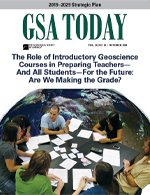
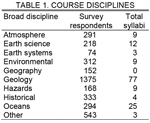 Table 1
Table 1 Figure 1
Figure 1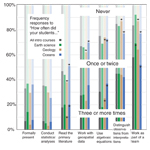 Figure 2
Figure 2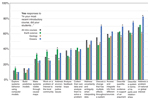 Figure 3
Figure 3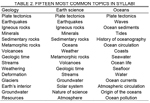 Table 2
Table 2 Figure 4
Figure 4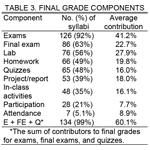 Table 3
Table 3